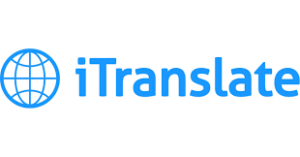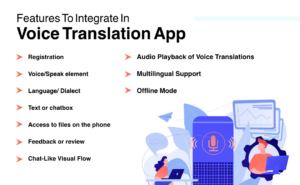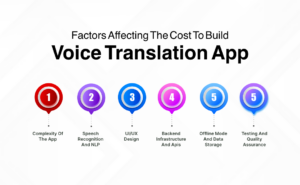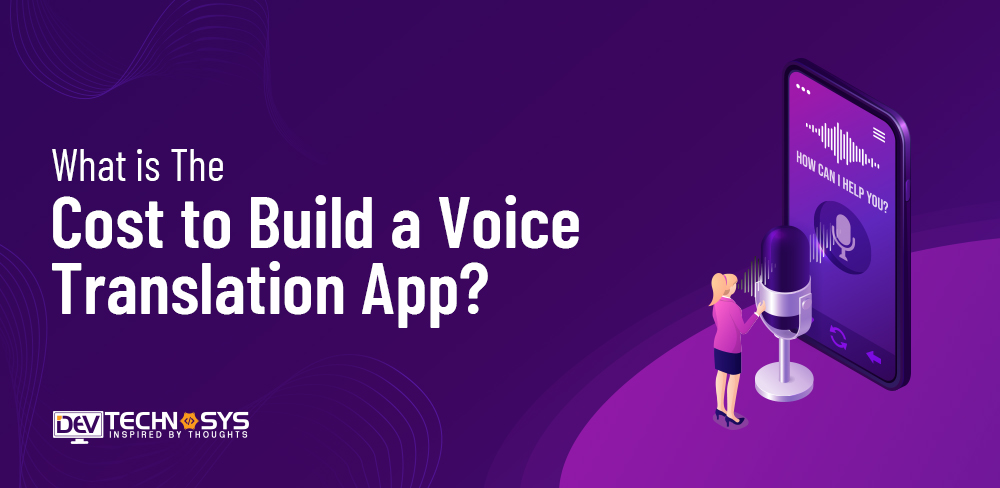“If you talk to a man in a language he understands, that goes to his head. If you talk to him in his language, that goes to his heart.”
Nelson Mandela
Voice translators have grown in popularity in recent years. They allow communication in multiple languages without a language barrier. Voice translator apps are useful for many reasons, including when you travel abroad, conduct business with foreign clients, or just want to communicate with someone who speaks another language.
When considering investing in or developing a new app, businesses often ask, “How much will it cost to build a voice translation app?” This depends on many factors such as the complexity of the app, its features and languages, the location of the development team, and their experience.
Thus, we will discuss the factors that affect the cost to build a voice translation app. We’ll also provide an estimation of the costs involved.
So let’s begin.
What are Voice Translation Apps?

Voice translation apps are mobile applications or software tools that use speech recognition and translation technologies to convert spoken phrases or words from one language into another in real-time. Users of these applications may instantaneously converse with persons who speak different languages.
Voice translation apps use advanced algorithms and machine-learning techniques to accurately identify and transcribe the spoken language. The transcribed texts are then converted into the desired languages by translation engines. Text-to-speech technology can display the translated text on the screen or speak it aloud.
Voice Translation Market Insights
- In 2020, the global market to translate voice-to-text apps reached a value of USD 335 million. Market expansion is anticipated to continue from 2023 to 2028 at a CAGR of 9.5%. By 2026, it will reach USD 576 million.
- By 2020, NPR estimates that 52% of users who use voice assistants will be using them daily.
- In 2020, the total cost of speech-to-speech translation was USD 333.7 million. This number is expected to increase to USD 576.99 million in 2026.
- The market for machine translation is anticipated to reach $650 million by 2020 and increase at a CAGR of 25% by 2027.
- Global Voice and Speech Technology Market, which was valued at $8.3 billion in 2021 will reach $22,9 billion by the year 2026. It is unheard of to expect a 21.6% CAGR for the forecast period. Technology will be the most promising industry for the next few years.
- 45% of the worldwide market will be made up of North America. The region with the quickest growth is Asia Pacific.
- The B2C market is the main target for voice translation. B2B is working hard to integrate technology into business processes.
- According to market research, language-supporting apps are making their way into the legal, banking and financial, medical, travel, tourism, and other markets.
How Does the Voice Translation App Work?
Voice translation is a new level of translation. It offers in-conversation translations that translate your words into the target language immediately. This is a disruptive tool for business expansion and cross-cultural communication. Three technologies are the basis of the core features of voice translation:
- Automatic speech recognition – This app converts your words and voice into text.
- Machine translation (MT) – With the use of a machine translation module, the text is first modified and then translated.
- Voice synthesis (TTS) – the translated text is spoken by a native speaker in a target tongue.
Voice translation technology is in the early stages of voice translator app development, and its full potential has yet to be realized. We will be able to convert and translate accurate speech recognition into the target languages within seconds with machine learning algorithms that are constantly improving.
Example of Voice Translation Apps 2025
If you are looking to build a voice translation app or add translation to an existing product, it will take expertise and knowledge. You can find out what type of app is best for you by looking at the top voice translator apps available in 2022.
| Voice translation app | Available platforms | Download |
| Microsoft Translator | Android | iOS | 50M+ |
| iTranslate | Android | iOS | 50M+ |
| Google Translate | Android | iOS | 1B+ |
| TextGrabber | Android | iOS | 500K+ |
1. Microsoft Translator
![]()
Microsoft Translator, a free online and offline translation tool, supports more than sixty languages. This app is available for iOS and Android and can be used to translate text, voice, conversation, camera images, and screenshots.
Microsoft Translator is ranked second in the list of language translator apps for Android despite its excellent performance. Seventy languages are supported. It offers more languages than other Android translation applications, however less than Google Translate.
It can translate two-way conversations with up to 100 people instantly. There are no in-app purchases and the application itself is entirely free.
2. iTranslate

Popular iOS and Android app iTranslate provides translations in over 100 different languages. The app includes Nuance’s state-of-the-art speech recognition software and supports voice recognition for four languages in offline mode. iTranslate can be downloaded as a separate app for the Apple Watch.
This is a great option for users who are looking to translate in optimum convenience. Nevertheless, some reviews claim that it has better voice input than Google Translate. AirTranslate is a feature that allows two iOS devices to communicate with each other on the move.
3. Google Translate

Google Translate is the best voice-to-voice translator app because it’s the most popular and reliable translator for Android tablets. It is a popular app among Android users because it was the first translation app for Android phones. Google Translator is a useful tool, even if it doesn’t provide the best translations for Android. Google Translate for Android supports 108 different languages, 60 combinations of languages, and a host of other features.
4. TextGrabber

TextGrabber, a voice translator app for android, is the best way to read street signs, menus, electronic manuals, and other texts in another language even when you are not connected to the Internet. You only need to point your camera at printed text and the app will instantly translate it. It can recognize more than 100 online languages and 10 offline languages.
The Innovative Real-Time Recognition mode digitizes printed text directly onto the camera screen of your mobile phone, without you having to take a picture. Email addresses, phone numbers, links, and postal addresses are all clickable. Clicking on a hyperlink will allow you to instantly send an email, dial a number or locate an address in your map app.
Why Should Businesses Invest in Voice Translation apps?
Businesses should invest in voice translation applications for several reasons. In today’s globalized world, businesses interact with customers, partners, and clients from various countries and languages. Voice translation apps enable seamless communication, break down language barriers and foster better understanding and collaboration.
Second, voice translation applications improve customer service and support. By providing real-time language translation, businesses may raise customer satisfaction. Businesses in the retail, hospitality, and tourism industries can benefit from this.
Voice translation apps may also open new markets. Businesses can reach international markets by overcoming language barriers. They will also draw in a larger clientele and seize international commercial chances. This may lead to more income, sales, and business expansion.
Additionally, investing in voice-translation apps shows a commitment to diversity and inclusion. Businesses can demonstrate their commitment to diversity by providing tools that allow equal participation and access regardless of language. So now you know why businesses must invest in voice translation apps. You should now build a voice translation app for both platforms with the help of a hybrid app development company.
Features to integrate into the voice translation app

Features are the most important part of any app development. So we have listed down the essential features that you must integrate when you build a voice translation app. However, if you want to integrate the below features only for iOS devices, then it would be better to take help from an iOS app development services provider.
1. Registration
The registration of users should be designed so that the profile of each user can be imported easily from any social media platform. It is therefore a good idea to include social media logins.
2. Voice/Speak element
Users can easily express their opinions in a conversation by using the voice element or attribute.
3. Language/ Dialect
It is important to include all the languages spoken and used by people around the globe. The user will gain many benefits.
4. Text or chatbox
The user can easily understand the voice and the translation if the message has been sent via text or messenger. This feature allows the user to customize the application according to their interests.
5. Access to files on the phone
Voice translation apps allow users to access files directly from their mobile devices.
6. Feedback or review
It is important to include this feature, as it will help users provide feedback. The Share feature will make your app more popular, as people will share it and many users will get to know about the voice translation application. The share tool may be used to distribute audio transcriptions, written material, and more.
7. Chat-Like Visual Flow
The app should display your conversations in a visual chat-like flow. So, users can quickly identify the responder and initiator. Here, color differentiation and indentation are helpful.
8. Audio playback of voice translations
It is important to have the option of playing back your audio translation multiple times during your conversation. It will be useful if the user needs to repeat something back to their conversation partner.
9. Multilingual Support
This app should be able to support multiple languages and allow users to translate from one language pair into another.
10. Offline Mode
Users may download language packs and utilize them offline with several voice translation apps.
Technologies Used for Building Voice Translation App
To implement robust features into your voice translator application, you will need to work with multiple technologies and tools. It’s crucial to have a thorough grasp of the different phases to build a voice translation app.
However, you must have a good understanding of cloud integration and next-generation AI development to build a voice translation app that works in real-time.
Here are the best technologies and tools for voice translation app development, regardless of whether you start from scratch or want to integrate a component into your voice translation application.
1. Automatic Speech Recognition
ASR allows computers to recognize human speech and transcribe it. This technology is crucial for developing voice translator apps because it allows the app to understand what a user says.
2. Natural Language Processing
NLP is an AI branch that deals with interactions between computers, human languages, and other AI systems. The app is able to analyze and understand spoken language with NLP. This is crucial for accurate translation.
3. Machine Translation
MT is a technique that translates voice or text from one language into another using computers. The MT technology is essential for voice translator apps because it converts the user’s spoken language into the target.
4. Text to Speech
TTS allows computers to synthesize speech that sounds like human speech. The app converts the translated text to spoken words with TTS. For the user to understand the translation, this is crucial.
5. Voice Recognition and Synthesis
It is essential that the app recognizes the user’s voice, and synthesizes speech in a human-like manner. The app can be integrated with the React Native app development for budget-friendly and cost-effective.
6. Cloud-based Services
Cloud-based services provide access to language models that have already been built. This can speed up development and improve accuracy in the app’s translation capability.
Factors Affecting the Cost to Build a Voice Translation App

The cost of developing a voice translation application is affected by a number of factors. Seven key factors can influence the cost of developing a voice-translation app. These factors are given by android app development solutions. So let’s have a look:
1. Complexity of the App
The complexity and size of the app will determine the cost of development. Apps with advanced features such as offline mode, real-time translation, and multilingual support require more complex programming, which can increase development costs and time.
2. Speech Recognition and NLP
Accurate speech processing and recognition are essential for voice translation apps. It can take a long time to develop robust algorithms and models capable of accurately recognizing and processing different accents, dialects, and speech patterns. The higher the cost of development, the more accurate and advanced the speech recognition capability.
3. UI/UX design
An intuitive and user-friendly interface is essential for the success and popularity of voice translation apps. Designers and developers are required to design and develop an attractive user interface, which is easy to navigate and offers a seamless translation. The complexity and degree of the user interface’s quality might have an impact on the cost to develop a mobile app.
4. Backend Infrastructure and APIs
Voice translation applications often require a robust infrastructure in the backend to handle tasks such as speech recognition, translation, and other processing. The cost of developing and maintaining servers, databases, and APIs as well as integrations with third-party services can be high.
5. Offline Mode and Data Storage
An offline mode in a voice translator app is desirable as it allows the user to translate without internet access. Implementing offline functionality requires extra development effort, including downloading and storing local language packs on the device of the user. The difficulty of establishing offline modes might have an impact on development costs.
6. Testing and Quality Assurance
Thorough testing and quality control processes are essential to ensure reliability, accuracy, and performance for a voice translation application. Time and resources are needed to conduct comprehensive testing. This includes functional testing as well as compatibility and user acceptance tests. The higher the cost of development, the more rigorous the testing procedure.
The cost can also be affected by the availability of developers with the right skills, the project management process, the documentation, and ongoing updates, as well as the integration with third-party services and APIs.
How Much Does It Cost to Build a Voice Translation App?
Voice and real-time translation apps are potential business ideas. They can provide a billion translations per day and support millions of communications around the world. Let’s first find out a quick answer to the question “How much does it cost to build a voice translation app?”
The cost to build a voice translation app would range between $25,000 and $50.000. The price is calculated on the basis of minimum viable features, without support or maintenance after release. The cost can change dramatically or slightly with each new feature. Also, the cost to hire an app developer will be around $15-$25.
The pre-set features, the number of platforms, and the particular needs can all affect the pricing. It might be challenging to make a pricing estimate for the stakeholders in the early phases of a project. Therefore, it is better to consult a mobile app development company to get an accurate cost estimation for building a voice translation app.
Conclusion
These apps are becoming increasingly popular because they convert speech into the desired language within seconds. If you’re interested in creating a voice translation app, you may want to hire an on-demand app development company that can help you choose the correct technologies and methodologies for this app. Apps can translate speech in any form, whether it is a phrase, a sentence, or a single word. You only need to bring your idea, and the experts will turn it into an original product.
FAQ
How much time does it take to build a voice translation app?
The time required to build a voice translation app can vary depending on the complexity of the app, desired features, development resources, and team size. Generally, it can take 4-6 months or more to develop a fully functional and robust voice translation app.
How to Build a Voice Translator app?
In order to build a voice translations app, you must follow the below steps:
- Develop speech recognition capabilities.
- Implement translation algorithms for different languages.
- Create a user-friendly interface for input/output.
- Test and optimize for accuracy and performance.
- Consider additional features like offline mode and pronunciation assistance.















